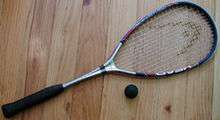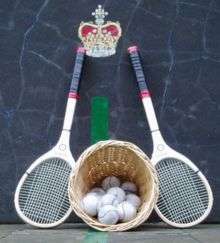Racket (sports equipment)


A racket or racquet[1] is a sports implement consisting of a handled frame with an open hoop across which a network of strings or catgut is stretched tightly. It is used for striking a ball or shuttlecock in games such as squash, tennis, racquetball, and badminton. Collectively, these games are known as racket sports. This predecessor to the modern game of squash, rackets, is played with 30 1⁄2-inch-long (77 cm) wooden rackets. While squash equipment has evolved in the intervening century, rackets equipment has changed little.
The frame of rackets for all sports was traditionally made of laminated wood and the strings of animal intestine known as catgut. The traditional racket size was limited by the strength and weight of the wooden frame which had to be strong enough to hold the strings and stiff enough to hit the ball or shuttle. Manufacturers started adding non-wood laminates to wood rackets to improve stiffness. Non-wood rackets were made first of steel, then of aluminium, and then carbon fiber composites. Wood is still used for real tennis, rackets, and xare. Most rackets are now made of composite materials including carbon fibre or fiberglass, metals such as titanium alloys, or ceramics.
Catgut has partially been replaced by synthetic materials including nylon, polyamide, and other polymers. Rackets are restrung when necessary, which may be after every match for a professional or never for a social player.
Spelling
Racket is the standard spelling of the word. Racquet is an alternative spelling[2][3] used more commonly in certain sports (squash, racquetball, badminton) and less commonly in others (tennis).[1] Racket is the preferred spelling in tennis.[1] While some writers, especially those outside North America, prefer the French-influenced racquet, racket is the predominant spelling by a large margin.[1] Similarly, while some believe that racket came about as a misspelling of racquet, racket is in fact the older spelling: it has been in use since the 16th century, with racquet only showing up later in the 19th century as a variant of racket.[1]
Etymology
The origin of the term "racket" is unclear. According to a popular belief first published by Malcolm Whitman in 1932, the expression comes from the Arabic term rahat al-yad, meaning "palm of hand".[4] Modern research however reveals this thesis in a highly questionable light.[5] Instead, the term is more likely to be derived from the Flemish word "raketsen" which is itself derived from Middle French "rachasser", meaning "to strike (the ball) back".[6]
Badminton

Badminton rackets are light, with top quality rackets weighing between about 80 and 100 grams (with strings). Modern rackets are composed of carbon fibre composite (graphite reinforced plastic), which may be augmented by a variety of materials. Carbon fibre has an excellent strength to weight ratio, is stiff, and gives excellent kinetic energy transfer. Before the adoption of carbon fibre composite, rackets were made of wood to their excessive weight and cost.
There is a wide variety of racket designs, although the racket size and shape are limited by the Laws. Different rackets have playing characteristics that appeal to different players. The traditional oval head shape is still available, but an isometric head shape is increasingly common in new rackets. Various companies have emerged but Yonex of Japan and Li-Ning of China are the dominant players in the market. Majority of top tournaments are sponsored by these companies. Every year a new technology is introduced by these companies but predominantly, all rackets are made of carbon graphite composite. Lin Dan was the winner of the most World Championships men's singles titles. He became the first man to win back-to-back badminton singles titles at the Olympic Games in 2012.[7]
Rackets
This predecessor to the modern game of squash, rackets, is played with 30 1⁄2-inch (770 mm) wooden rackets. While squash equipment has evolved in the intervening century, rackets equipment has changed little.
Racquetball
According to the current racquetball rules[8] there are no limitations on the weight of a racquetball racket.
- The racket, including bumper guard and all solid parts of the handle, may not exceed 22 inches in length.
- The racket frame may be any material judged safe.
- The racket frame must include a cord that must be securely attached to the player's wrist.
- The string of the racket must be gut, monofilament, nylon, graphite, plastic, metal, or a combination thereof, and must not mark or deface the ball.
- Using an illegal racket will result in forfeiture of the game in progress or, if discovered between games, forfeiture of the preceding game.
Racquetball rackets, unlike many other types, generally have little or no neck, the grip connecting directly to the head. They also tend to have head shapes that are notably wider at the top, with some older rackets looking almost triangular or teardrop shaped.
Real tennis

In real tennis, 27-inch (686-mm) long rackets are made of wood and very tight strings to cope with the game's heavy balls. The racket heads are bent slightly to make striking balls close to the floor or in corners easier.
Squash
Standard squash rackets are governed by the rules of the game. Traditionally they were made of laminated timber (typically Ash), with a small strung area using natural gut strings.[9] After a rule change in the mid-1980s, they are now almost always made of composite materials such as carbon fiber or metals (graphite, Kevlar, titanium, and/or boron) with synthetic strings.[9] Modern rackets are 70 cm long, with a maximum strung area of 500 square centimetres (approximately 75 square inches) and a mass between 90 and 200 grams (4–7 ounces).
Table tennis
Table tennis uses a table tennis racket made from laminated wood covered with rubber on one or two sides depending on the grip of the player. Unlike a conventional racket, it does not contain strings strung across an open frame. This is called either a paddle, racket, or a bat, with usage differing by region. In the USA the term "paddle" is common, in Europe the term is "bat", and the official ITTF term is "racket."
Table Tennis racket specs are defined at the ITTF handbook section 2.04[10] and currently include the following.
| 2.04.01 | The racket may be of any size, shape or weight but the blade shall be flat and rigid. |
| 2.04.02 | At least 85% of the blade by thickness shall be of natural wood; an adhesive layer within the blade may be reinforced with fibrous material such as carbon fibre, glass fibre or compressed paper, but shall not be thicker than 7.5% of the total thickness or 0.35mm, whichever is the smaller. |
| 2.04.03 | A side of the blade used for striking the ball shall be covered with either ordinary pimpled rubber, with pimples outwards having a total thickness including adhesive of not more than 2.0mm, or sandwich rubber, with pimples inwards or outwards, having a total thickness including adhesive of not more than 4.0mm. |
| 2.04.03.01 | Ordinary pimpled rubber is a single layer of non-cellular rubber, natural or synthetic, with pimples evenly distributed over its surface at a density of not less than 10 per cm2 and not more than 30 per cm2. |
| 2.04.03.02 | Sandwich rubber is a single layer of cellular rubber covered with a single outer layer of ordinary pimpled rubber, the thickness of the pimpled rubber not being more than 2.0mm. |
| 2.04.04 | The covering material shall extend up to but not beyond the limits of the blade, except that the part nearest the handle and gripped by the fingers may be left uncovered or covered with any material. |
| 2.04.05 | The blade, any layer within the blade and any layer of covering material or adhesive on a side used for striking the ball shall be continuous and of even thickness. |
| 2.04.06 | The surface of the covering material on a side of the blade, or of a side of the blade if it is left uncovered, shall be matt, bright red on one side and black on the other. |
| 2.04.07 | The racket covering shall be used without any physical, chemical or other treatment. |
| 2.04.07.01 | Slight deviations from continuity of surface or uniformity of colour due to accidental damage or wear may be allowed provided that they do not significantly change the characteristics of the surface. |
| 2.04.08 | Before the start of a match and whenever he or she changes his or her racket during a match a player shall show his or her opponent and the umpire the racket he or she is about to use and shall allow them to examine it. |
Tennis

The parts of a tennis racket are the head, rim, face, neck, butt/butt cap, handle and strings.
Modern tennis rackets vary in length, weight, and head size. 21 to 26 inches (53 to 66 cm) is normally a junior's length, while 27 and 27.5 inches (69 and 70 cm) are for stronger and taller adult players. Some are also available at lengths of 28 to 29 inches (71 to 74 cm). Weights of a racket also vary between 8 ounces (230 g) unstrung and 12.5 ounces (350 g) strung. Rackets originally flared outward at the bottom of the handle to prevent slipping. The rounded bottom was called a bark bottom after its inventor Matthew Barker. But by 1947, this style became superfluous. Head size also plays a role in a racket's qualities. A larger head size generally means more power and a larger "sweet spot" that is more forgiving on off-center hits. A smaller head size offers more precise control. Current racket head sizes vary between 85–137 square inches (550–880 cm2), with most players adopting one from 95–105 square inches (610–680 cm2). Rackets that are mid way in weight, size and player ability, are often called "tweener rackets."[11]

Vibration dampers (also commonly known as "gummies") may be interlaced in the proximal part of the string array for improved feel.[12]
Throughout most of tennis' history, rackets were made of laminated wood, with heads of around 65 square inches (420 cm2). In the late 1960s, Wilson produced the T2000 steel racket with wire wound around the frame to make string loops. It was popularized by the top American player Jimmy Connors. In 1968 Spalding launched an aluminum racket, called The Smasher. Aluminium, though lighter and more flexible than steel, was less accurate than wood. Because of this, most of the top players still preferred to use wooden frames, and a decade later they were still in use.[13]
By 1975, aluminum construction improvements allowed for the introduction of the first "oversized" racket, which was manufactured by Weed. Prince popularized the oversize racket, which had a head size of approximately 110 square inches (710 cm2) and opened the door for the introduction of rackets having other non-standard head sizes such as mid-size (90 square inches) and mid-plus size (95 square inches).
In the early 1980s, "graphite" (carbon fibre) composites were introduced, and other materials were added to the composite, including ceramics, glass-fibre, boron, and titanium. The Dunlop Max200G used by John McEnroe from 1983 was an early graphite racket, along with the very popular Prince original graphite. Composite rackets are the contemporary standard, the last wooden racquet appeared at Wimbledon in 1987.[14]
Longer rackets were introduced by Dunlop[15] to give additional reach for shots such as the serve and volley where shorter players may be at a disadvantage. Mid-size or mid-plus rackets are the general standard for professional players.
Stringing (material, pattern, tension) is an important factor in the performance of a tennis racket. A few elite players use natural gut, but the vast majority of strings are a nylon or polyester synthetic. Some (American champion Pete Sampras is a prominent example) consider the natural string to be more responsive, providing a better "feel", but synthetic is favored for its much superior durability, consistency, as well as much lower cost. String pattern (the vertical/horizontal grid) is a function of the racket head size and design. A tighter pattern is considered to deliver more precise control; a more "open" pattern to offer greater potential for power and spin. Modern rackets are marked with a recommended string tension range. The basic rule is that a lower tension creates more power (from a "trampoline" effect) and a higher string tension creates more control (the less 'trampoline effect' the more predictable the power and angle of the departure from the string bed.)
References
- 1 2 3 4 5 "Racket vs. racquet". Grammarist. Retrieved 5 September 2012.
- ↑ "Racket". Merriam-Webster. Retrieved 5 September 2012.
- ↑ "Racket". Oxford Dictionaries. Retrieved 26 June 2013.
- ↑ Whitman, Malcolm D. (1932). Tennis : Origins and Mysteries (Dover ed.). Mineola, N.Y.: Dover Publications. ISBN 0486433579.
- ↑ Gillmeister, Heiner (1998). Tennis : A Cultural History. Washington Square, N.Y.: New York University Press. p. 5. ISBN 081473121X.
- ↑ Gillmeister, Heiner (1998). Tennis : A Cultural History. Washington Square, N.Y.: New York University Press. p. 123. ISBN 081473121X.
- ↑ Glenday, Craig (2013). Guinness World records 2014. p. 1. ISBN 978-1-908843-15-9.
- ↑ USAR OFFICIAL RULES OF RACQUETBALL
- 1 2 "Grays of Cambridge: History" - makers of rackets and founded in 1855 by Henry John Gray, the Champion Racquets Player of England. "In those days, the rackets were made from one piece English ash, with a suede leather grip and natural gut. ... The 1980s witnessed a period of re-structuring and consolidation. The Cambridge racquets factory was forced to close in face of the move to graphite rackets, and production was moved to the Far east."
- ↑ "ITTF Handbook". www.ittf.com. Retrieved 2016-05-22.
- ↑ "Tennis Now gear review: Tweener rackets". Retrieved 22 June 2015.
- ↑ http://www.tenniscompanion.org/an-in-depth-look-at-tennis-racquet-vibration-dampeners/
- ↑ "BBC: The quest for the tennis sweet spot". Retrieved 10 September 2015.
- ↑ http://news.bbc.co.uk/sport1/hi/tennis/rules_and_equipment/4227178.stm
- ↑ An evolutionary history of tennis racquets
External links
| Look up racket in Wiktionary, the free dictionary. |
- Tennis racket design by Howard Head; (1974) Smithsonian Institution Libraries
- The History of Tennis Racquets — Evolution of the Modern Racquet
- How Products are Made - Tennis Racket
- Tips on Choosing The Best Badminton Racket
- Gelberg, J. Nadine, "The Big Technological Tennis Upset", Invention & Technology magazine, 1997